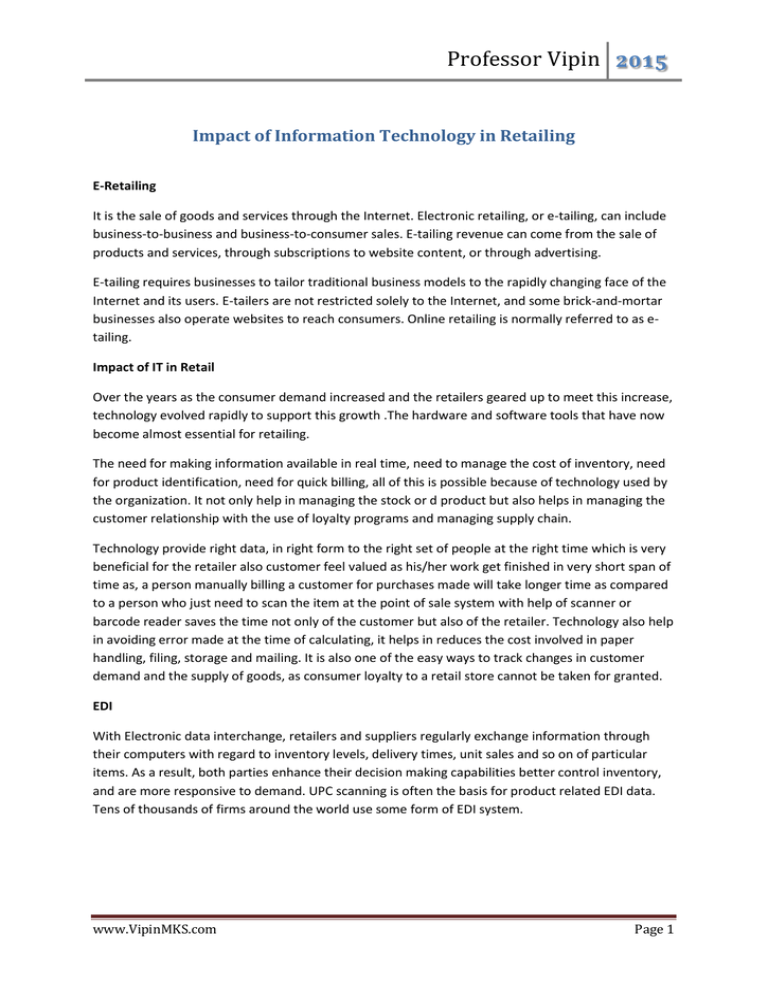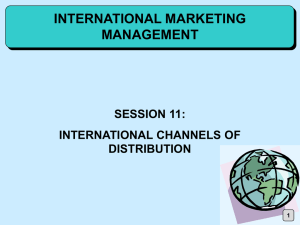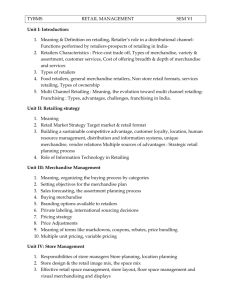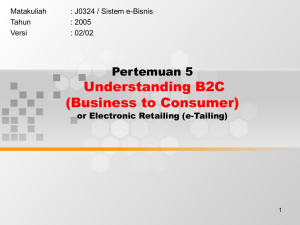Professor Vipin 2015 Impact of Information Technology in Retailing
advertisement

Professor Vipin 2015 Impact of Information Technology in Retailing E-Retailing It is the sale of goods and services through the Internet. Electronic retailing, or e-tailing, can include business-to-business and business-to-consumer sales. E-tailing revenue can come from the sale of products and services, through subscriptions to website content, or through advertising. E-tailing requires businesses to tailor traditional business models to the rapidly changing face of the Internet and its users. E-tailers are not restricted solely to the Internet, and some brick-and-mortar businesses also operate websites to reach consumers. Online retailing is normally referred to as etailing. Impact of IT in Retail Over the years as the consumer demand increased and the retailers geared up to meet this increase, technology evolved rapidly to support this growth .The hardware and software tools that have now become almost essential for retailing. The need for making information available in real time, need to manage the cost of inventory, need for product identification, need for quick billing, all of this is possible because of technology used by the organization. It not only help in managing the stock or d product but also helps in managing the customer relationship with the use of loyalty programs and managing supply chain. Technology provide right data, in right form to the right set of people at the right time which is very beneficial for the retailer also customer feel valued as his/her work get finished in very short span of time as, a person manually billing a customer for purchases made will take longer time as compared to a person who just need to scan the item at the point of sale system with help of scanner or barcode reader saves the time not only of the customer but also of the retailer. Technology also help in avoiding error made at the time of calculating, it helps in reduces the cost involved in paper handling, filing, storage and mailing. It is also one of the easy ways to track changes in customer demand and the supply of goods, as consumer loyalty to a retail store cannot be taken for granted. EDI With Electronic data interchange, retailers and suppliers regularly exchange information through their computers with regard to inventory levels, delivery times, unit sales and so on of particular items. As a result, both parties enhance their decision making capabilities better control inventory, and are more responsive to demand. UPC scanning is often the basis for product related EDI data. Tens of thousands of firms around the world use some form of EDI system. www.VipinMKS.com Page 1 Professor Vipin 2015 Bar Coding For over 20 years manufacturers, retailers, and distributors have used barcode labelling to better manage their inventories, proving that a relatively simple, cost-effective system provides up-to-theminute information on inventory status. When integrated into an existing information system, barcoding allows you to track your merchandise and to conduct both full-scale inventories department-wide cycle counts. Inventory can be reconciled in a day instead of weeks. And barcoding provides more accurate data while saving both time and costs. Electronic Article Surveillance Electronic article surveillance (EAS) is a technological method for preventing shoplifting from retail stores, pilferage of books from libraries or removal of properties from office buildings. Special tags are fixed to merchandise or books. These tags are removed or deactivated by the clerks when the item is properly bought or checked out. At the exits of the store, a detection system sounds an alarm or otherwise alerts the staff when it senses active tags. Some stores also have detection systems at the entrance to the bathrooms that sound an alarm if someone tries to take unpaid merchandise with them into the bathroom. For highvalue goods that are to be manipulated by the patrons, wired alarm clips may be used instead of tags. Electronic Shelf Labels An electronic shelf label (ESL) system is used by retailers for displaying product pricing on shelves. Typically, electronic display modules are attached to the front edge of retail shelving. These modules use liquid-crystal display (LCD) or similar screen technologies to show the current product price to the customer. A communication network allows the price display to be automatically updated whenever a product price is changed. This communication network can be based on radio, infrared or even visible light communication. Customer Database Management System Customer data management (CDM) is the ways in which businesses keep track of their customer information and survey their customer base in order to obtain feedback. CDM embraces a range of software or cloud computing applications designed to give large organizations rapid and efficient access to customer data. Surveys and data can be centrally located and widely accessible within a company, as opposed to being warehoused in separate departments. CDM encompasses the collection, analysis, organizing, reporting and sharing of customer information throughout an organization. Businesses need a thorough understanding of their customers’ needs if they are to retain and increase their customer base. Efficient CDM solutions provide companies with the ability to deal instantly with customer issues and obtain immediate feedback. As a result, customer retention and customer satisfaction can show dramatic improvement. www.VipinMKS.com Page 2 Professor Vipin 2015 Legal and Ethical Issues in Retailing Retailers have realized the advantages of reflecting an ethical sense in business operations. The organizational environment plays a major role in the kind of ethical sense the employees possess. Retailers are trying to ensure that their employees behave ethically. Though there are many laws influencing the business environment of the retailer, there are many more aspects that come under the purview of ethics. These aspects concern the merchandise buying and selling practices in the firm. Retailers also need to be socially responsible and environmentally concerned. They often undertake activities that are beneficial to the society. Retailers are also taking measures for waste reduction, trying to recycle the materials used and are switching over to environment friendly packaging materials. Legislation governs the retail firm's operations and relations with its channel partners. Its relations with suppliers, competitors, consumers and employees are governed by appropriate laws. Legal restrictions are imposed on practices concerning pricing, product, promotion, distribution, trademarks and HR policies. www.VipinMKS.com Page 3









